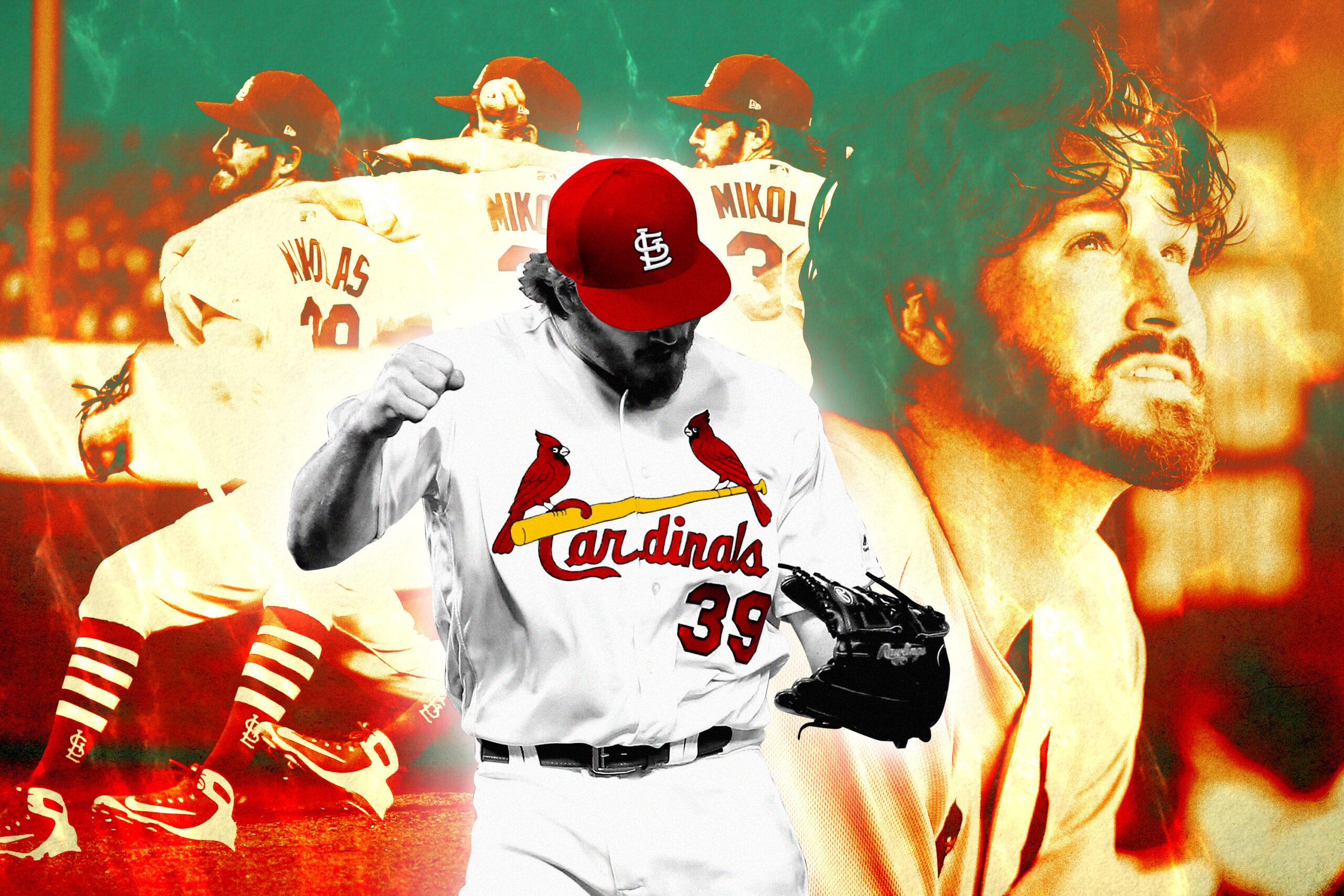
Shohei Ohtani wasn’t the only starting pitcher to leave Japan’s Nippon Professional Baseball for MLB last winter. And based on just the results from the first two months of the 2018 season, he hasn’t been the best starting pitcher to cross the Pacific, either.
Miles Mikolas doesn’t have close to Ohtani’s name recognition, or dedicated coverage, or bat skills, but the 29-year-old Cardinal has quietly excelled in 2018. Even after a lackluster start on Sunday, in which he allowed four runs over six innings against Pittsburgh, Mikolas still has a WHIP below 1, and he still ranks ninth among qualifying NL starters in both ERA (2.58) and FIP (3.16). Mikolas doesn’t cut a particularly striking presence on the mound; his most notable aesthetic identifier is not a triple-digit fastball with movement or a deviously darting splitter, but rather his pair of high socks, striped Cardinals red, white, and blue like a wadded-up Missouri state flag is clinging to his ankles.
But Mikolas is a striking presence in the literal baseball sense of the word, and that ability means his effectiveness shouldn’t cease anytime soon. He’s not Ohtani, and he’s not on the Scherzer–deGrom–Nola tier atop the National League, but as a strike-throwing, walk-avoiding, zone-dwelling hurler, Mikolas is proving that even amid a leaguewide trend toward a homogenous three true outcomes style, there isn’t just one path to success as an MLB pitcher. And as a former MLB washout, throwing at an All-Star level for even two months deserves ample recognition in itself.
This isn’t Mikolas’s first stint in the majors, but it’s already his most successful. He was a cromulent reliever for the Padres in 2012 (and briefly in 2013), then a woeful starter over 10 games for the Rangers in 2014: His 6.44 ERA that year ranked 329th out of 332 pitchers who threw at least 50 innings, and his peripherals were so uninspiring that he was forced overseas to continue his professional career. He rebounded with the Yomiuri Giants in Japan, though, and spent the next three seasons dancing around NPB bats despite playing in a hitter-friendly park. From 2015 to 2017, Mikolas registered fewer walks and strikeouts than Ohtani, but he was just as successful in his ultimate goal of preventing base runners and runs.
NPB Statistics, 2015-17
MLB teams took notice, and the Cardinals inked Mikolas to a two-year, $15.5 million deal in December, just three days before Ohtani shocked the baseball world by announcing he was signing with the Angels. After an uneven spring training, Mikolas stumbled through his first two regular-season starts, allowing four runs each in consecutive games against the Brewers. Then he went seven consecutive starts allowing two runs or fewer, including a seven-inning shutout of the Cubs and a complete-game shutout against the Royals.
Even if an ERA in the mid-2s isn’t sustainable long term, Mikolas has evinced enough positive signs that he should remain a comfortably above-average pitcher. He has a grasp of the fundamental skill of strike-throwing, which is often a challenge even for MLB pitchers: In 3-0 counts, when the only objective is to find the plate, pitchers spot the zone only 60 percent of the time. Yet in an era in which more pitchers are leaving the zone to induce whiffs, Mikolas has stayed the traditional course, and he ranks second among 90 qualifying starters in frequency of pitches inside the zone (56 percent).
Mikolas isn’t wholly dependent on strikes inside the zone, though; he has also induced a higher chase rate on would-be balls than, among others, Stephen Strasburg, Justin Verlander, and Gerrit Cole. Although he doesn’t induce out-of-zone whiffs quite like those aces, he still capitalizes on those chases with soft contact and enough swings-and-misses to get by: Opposing hitters are batting just .155 against him with one extra-base hit when they end an at-bat with a swing outside the zone.
That enviable combination of strikes inside and outside the zone gives Mikolas the majors’ highest overall strike rate (69 percent). Throwing strikes doesn’t by itself create a good pitcher, but it’s the best building block; beyond Mikolas, the top of the strike leaderboard is littered with other pleasant 2018 surprises—Ross Stripling, Marco Gonzales—and the best pitchers in baseball. Max Scherzer, Cole, Luis Severino, Jacob deGrom, Corey Kluber, and Verlander all rank in the top 10.
While Mikolas’s relatively lower strikeout totals separate him from the likes of Scherzer and Verlander, he doesn’t embody the complete control-pitcher archetype; he’s not a soft tosser. His four-seamer has touched 98.8 miles per hour and averages a shade over 95, putting him between Verlander and Chris Sale on the velocity leaderboard, while his sinker sits at 94 and even his lightly used changeup breaks 90.
But his fastballs, by themselves, are not particularly effective pitches, as opposing batters are hitting a combined .262 with a .403 slugging percentage against his four-seamer and sinker. Rather, he gets his outs from a pair of breaking balls. Against his slider, batters are hitting .179 and slugging .214; against his curve, they’re hitting .185 and slugging .259. Those pitches have made Mikolas one of the majors’ most potent pitchers against right-handed hitters, and the fact Mikolas throws both a slider and a curve at all makes him an outlier yet again. Most pitchers either choose one exclusively or favor it above the other breaker, lest the two pitches blend into each other to produce a shapeless, hittable slurve, but Mikolas controls each offering and throws them about equally. He’s the only qualified starter to throw both a slider and curveball with at least 20 percent of his pitches.
Mikolas’s familiarity with the strike zone is important here, too, because his ability to start plate appearances with strikes makes it easier for him to wield his breaking balls. Mikolas has the majors’ highest strike rate on the first pitch of an at-bat (70.5 percent), and he’s been behind in the count for just 19.7 percent of his pitches, giving him the third-lowest rate among pitchers with 500 total pitches this season. Because he’s rarely behind, he can throw any one of his handful of pitches at almost any time. Mikolas doesn’t exude dominance with his offerings in a vacuum, but his stuff plays up when hitters are off balance and unsure what pitch is coming next.
Throwing so many strikes and staying ahead in the count also limits the most glaring mistakes a pitcher can make. Mikolas has walked zero batters in half of his starts and hasn’t gone above two bases on balls in any game, and he’s allowed just six home runs in 10 starts (three coming in his first start of the year).
That combination places Mikolas in historic territory. Before this season, there were 32 occasions in MLB history in which a qualified starter allowed less than one walk per nine innings and less than one home run per nine. But most were the result of a primeval era of baseball, as 24 came before or during World War II, and another four before the wild-card era. Since then, as homers have risen, only four seasons qualify on both counts: Greg Maddux in 1995 and 1997, Cliff Lee in 2010, and Phil Hughes in 2014. Even Hughes, the least prestigious member of that club, received Cy Young consideration that year. It’s impossible to so thoroughly limit the two bad true outcomes without posting stellar overall numbers.
This isn’t to suggest that Mikolas is actually a pitcher on Verlander’s level, or that he will be better than Ohtani going forward. Ohtani, who is still just 23 years old, could be the best pitcher in baseball someday, and all else being equal, a strikeout is the ideal result a pitcher can obtain in any given plate appearance. Mikolas, who hasn’t reached double-digit Ks once this season, will never amass elite strikeout totals. But just like in Japan, Mikolas arriving at his outs via a different route doesn’t mean he has been any less successful. Mikolas even hit his first MLB home run before Ohtani, with a 407-foot drive off the Brewers’ Zach Davies in his first start of the year. (Don’t get too excited here, though. Mikolas still has just that one hit in 21 total at-bats.)
Given St. Louis’s modest investment in Mikolas over the winter, moreover, he has been even more valuable relative to expectations. FanGraphs’ financial valuation model calculates that Mikolas has already been worth $11.6 million to St. Louis this season, meaning in another month at his current pace, he’ll already have been worth his entire two-year contract. It’s still early in his deal and his St. Louis tenure comprises just one hot streak, but that streak was sufficiently hot that it vindicates the Cardinals front office and stat-savvy projection systems that saw value in the Yomiuri arm.
Just because Mikolas has already proved his worth doesn’t mean he’s maxed out his potential, though. His walk and home run numbers are so stingy that he has room to regress while remaining effective, and he throws enough consistent strikes that he will never beat himself. He’ll beat opposing hitters, instead. And for a player with an itinerant career, and a team that prides itself on an ability to locate and develop lesser-heralded talent, that’s all Mikolas and the Cardinals can ask.

